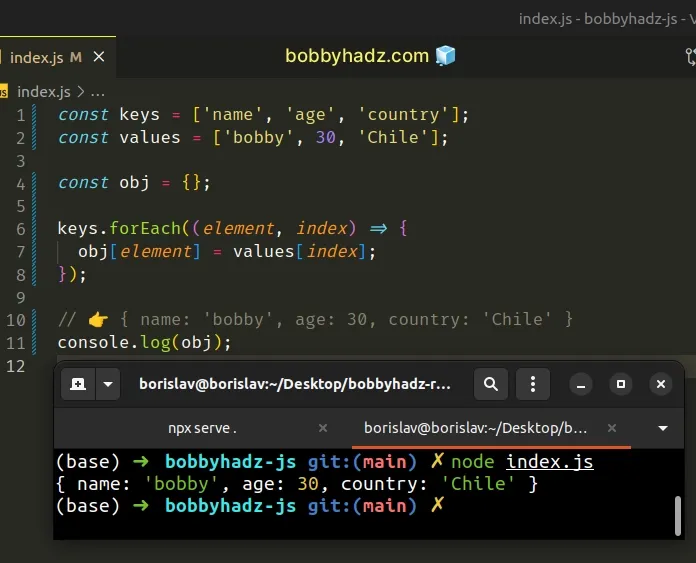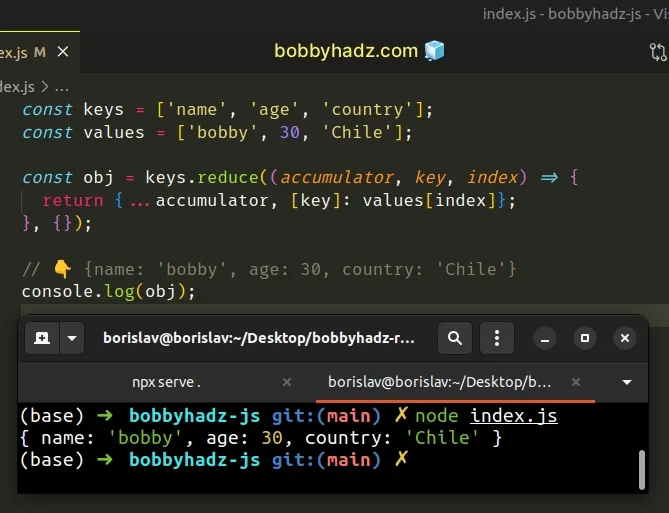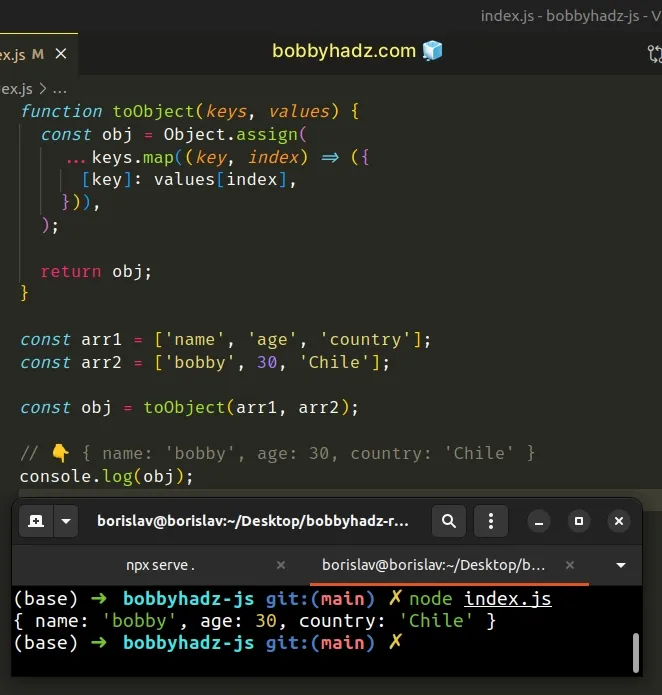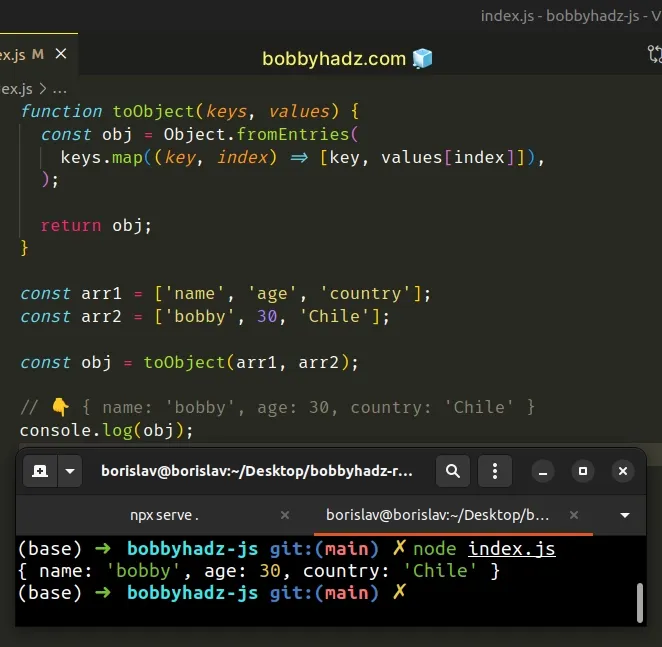Create an Object from Two Arrays in JavaScript
Last updated: Mar 4, 2024
Reading time·4 min

# Create an Object from Two Arrays in JavaScript
To create an object from two arrays:
- Use the
Array.forEach()method to iterate over the array of keys. - Use the index to access the element from the values array.
- On each iteration, assign the key-value pair to an object.
const keys = ['name', 'age', 'country']; const values = ['bobby', 30, 'Chile']; const obj = {}; keys.forEach((element, index) => { obj[element] = values[index]; }); // 👉️ { name: 'bobby', age: 30, country: 'Chile' } console.log(obj);

The function we passed to the Array.forEach() method gets called with each element in the array.
The function gets passed the following 3 parameters:
- The current
element. - The
indexof the iteration. - The
arrayitself.
After the method has finished iterating, the object contains the key-value pairs from the two arrays.
If you have to do this often, define a reusable function.
function toObject(keys, values) { const obj = {}; keys.forEach((element, index) => { obj[element] = values[index]; }); return obj; } const arr1 = ['name', 'age', 'country']; const arr2 = ['bobby', 30, 'Chile']; const obj = toObject(arr1, arr2); // 👇️ { name: 'bobby', age: 30, country: 'Chile' } console.log(obj);
The toObject() function takes two arrays as parameters, creates an object from
the two arrays and returns the result.
An alternative, but more functional approach is to use the Array.reduce() method.
# Create an Object from Two Arrays using Array.reduce()
This is a three-step process:
- Use the
reduce()method to iterate over the keys array. - Provide an empty object as the initial value for the accumulator.
- Using the index, assign the key-value pair to the accumulated object.
const keys = ['name', 'age', 'country']; const values = ['bobby', 30, 'Chile']; const obj = keys.reduce((accumulator, key, index) => { return {...accumulator, [key]: values[index]}; }, {}); // 👇️️ {name: 'bobby', age: 30, country: 'Chile'} console.log(obj);

reduce() method gets called for each element in the array.We provided an empty object as the initial value of the accumulator variable.
On each iteration, we use the
spread syntax (...) to
unpack the key-value pairs of the accumulator into a new object, then add the
current key-value pair and return the result.
Once the reduce() method has iterated over the entire array, the accumulator
object contains the key-value pairs from the two arrays.
If you have to do this often, define a reusable function.
function toObject(keys, values) { const obj = keys.reduce((accumulator, key, index) => { return {...accumulator, [key]: values[index]}; }, {}); return obj; } const arr1 = ['name', 'age', 'country']; const arr2 = ['bobby', 30, 'Chile']; const obj = toObject(arr1, arr2); // 👇️ { name: 'bobby', age: 30, country: 'Chile' } console.log(obj);
The function takes 2 arrays as parameters and creates an object from the two arrays.
# Create an Object from Two Arrays using Object.assign()
This is a three-step process:
- Use the
Array.map()method to iterate over the array of keys. - Return an object containing the current key-value pair on each iteration.
- Use the
Object.assign()method to merge the objects.
function toObject(keys, values) { const obj = Object.assign( ...keys.map((key, index) => ({ [key]: values[index], })), ); return obj; } const arr1 = ['name', 'age', 'country']; const arr2 = ['bobby', 30, 'Chile']; const obj = toObject(arr1, arr2); // 👇️ { name: 'bobby', age: 30, country: 'Chile' } console.log(obj);

The function we passed to the Array.map() method gets called with each element in the array.
On each iteration, we return an object containing the key from the first array and the value from the second array.
const arr1 = ['name', 'age', 'country']; const arr2 = ['bobby', 30, 'Chile']; // 👇️ { name: 'bobby' } { age: 30 } { country: 'Chile' } console.log( ...arr1.map((key, index) => ({ [key]: arr2[index], })), );
The map() method returns a new array containing the values returned from the
callback function.
The last step is to use the Object.assign() method to merge the objects into a
single object.
# Create an Object from Two Arrays using Object.fromEntries()
This is a three-step process:
- Use the
Array.map()method to iterate over the keys array. - Return an array containing the current key-value pair on each iteration.
- Use the
Object.fromEntries()method to convert the array to an object.
function toObject(keys, values) { const obj = Object.fromEntries( keys.map((key, index) => [key, values[index]]), ); return obj; } const arr1 = ['name', 'age', 'country']; const arr2 = ['bobby', 30, 'Chile']; const obj = toObject(arr1, arr2); // 👇️ { name: 'bobby', age: 30, country: 'Chile' } console.log(obj);

We used the Array.map() method to create an array of key-value pair arrays.
const arr1 = ['name', 'age', 'country']; const arr2 = ['bobby', 30, 'Chile']; // 👇️ [ [ 'name', 'bobby' ], [ 'age', 30 ], [ 'country', 'Chile' ] ] console.log(arr1.map((key, index) => [key, arr2[index]]));
The last step is to pass the array of key-value pairs to the
Object.fromEntries() method.
The Object.fromEntries() transforms a list of key-value pairs into an object.
This only works if you have a two-dimensional array where each subarray contains 2 elements - the key and the value.
# Additional Resources
You can learn more about the related topics by checking out the following tutorials:

